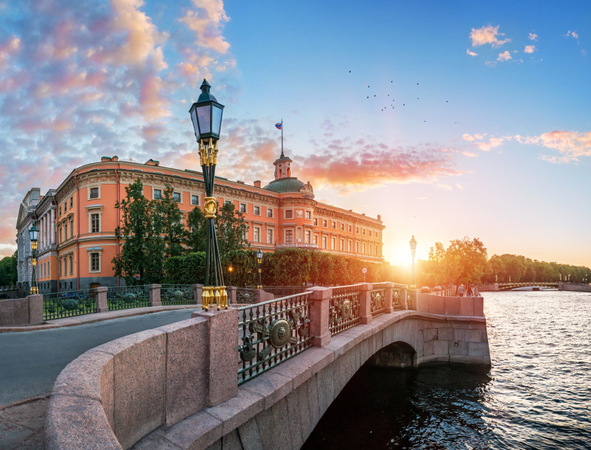The Kazan Cathedral (Cathedral of Our Lady of Kazan) is one of the largest churches in St. Petersburg, made in the Empire style. The cathedral was built on Nevsky Prospect in 1801-1811 by the architect A. Voronikhin. the laying of the foundation stone of the Kazan Cathedral took place on August 27, 1801. Before that, there was a small stone church of the Nativity of the Virgin, built in 1733-1737 by architect M. Zemtsov in the area around Nevsky Prospekt. There was kept the miraculous Icon of the Mother of God of Kazan, in whose honor the cathedral was named. The construction of the cathedral, which, on a plan of Emperor Paul I, was to resemble the St. Peter’s Basilica in the Vatican, was entrusted to architect Voronikhin, the former serf of Count Stroganov, who later became a professor at the Academy of Fine Arts. The construction of the cathedral took ten years. The Kazan Cathedral was the largest church of the early 19th century: its height is 71.5 meters, it is decorated with internal and external columns, carved out of huge granite monoliths, weighing 30 tons each. Voronikhin had a difficult task: according to the canons of the church, the altar of the church should be oriented to the east, respectively, the main entrance and facade — to the west. Following these canons, it turned out that the cathedral will face the main thoroughfare of St. Petersburg, Nevsky Prospekt, not by facade, but by side. Voronikhin brilliantly resolved this problem, decorated the northern facade of the cathedral with a colonnade, which is rotated to the Nevsky Prospekt. As conceived by the architect, one more the same colonnade was to decorate the south facade of the cathedral, but plans of Voronikhin were not implemented. The interior of the Kazan Cathedral is designed as a grand three-naved pillar hall. In the decoration of the interior of the cathedral are widely used marble, porphyry, jasper and Finnish granite. Inside and outside the cathedral is decorated with sculptures that were created by the best Russian masters such as Pimenov, Martos, Demuth-Malinovsky, and others. The external bronze sculptures represent Saint Vladimir, Saint Andrew, Saint John the Baptist and Saint Alexander Nevsky. An integral part of the interior of the cathedral is painting. Outstanding artists of the late 18th and early 19th centuries, such as Briullov, Bruni, Kiprensky, Borovikovsky, Ugryumov, and others painted the iconostasis of the cathedral, its walls and pillars of the dome. After the Patriotic War of 1812, the cathedral became an important monument of Russian military glory. In 1813, there was buried general M. Kutuzov and were placed the keys of the captured cities, and other spoils of war. In 1837, on the 25th anniversary of the victory over Napoleon, in front of the cathedral, were mounted monuments to Field Marshals Kutuzov and Barclay de Tolly. After the Revolution of 1917, the cathedral was taken away from the Orthodox Church. In 1932, there was opened the Museum of the History of Religion and Atheism. The date of November 4, 1990, was the day of the cathedral's revival. Then on the feast of Our Lady of Kazan, for the first time after more than seventy years of interruption, the Divine Liturgy was celebrated in the Kazan Cathedral.

Your request has been sent successfully! Our travel expert will contact you shortly.
Your request has been sent successfully! Our travel expert will contact you shortly.